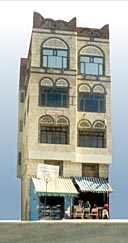
The House of Peace: Dar Al-Salam [Archives:1999/28/Law & Diplomacy]
July 12 1999
WHAT IS IT ABOUT?

As arbitration is one of the judicial roles, which reduces a major headache of the judicial branch, the head of the government passed a law of arbitration in the year 1992 and has passed various amendments. This law was proven by solving significant and complicated cases by means of International Arbitration. The case dealt with at that time was about the Al-Hunaish Archipelago. As a result, arbitration became the most common way to overcome disputes. This acceptance established various centers for arbitration at national, Arab and international levels. At the national level, the Yemeni center for Reconciliation and Arbitration and Al-Salaam Arbitration House were established. At the Arab level, the center for Arbitration in Rabat was established in 1987, as well as the Arbitration Center in Cairo, the Arbitration Center in Riyadh and some other centers. At the international level, many arbitration centers were established and the most prominent ones are the Arbitration Court for International Chambers of Commerce, which was founded in 1892, and is considered to be the oldest arbitration house, the American Arbitration Society in New York, the Arbitration Society in Paris, and the Arbitration Center for Chambers of commerce in Vienna.
This Arbitration House was founded for the service and assistance of those who prefer to solve their disagreements by arbitration, using judges, scholars, lawyers, and accountants, all experts who possess high efficiency and a strong conscience. So we hope, God willing, to open branches of the house all over the country.
Aims of Al-Salam Arbitration House
1- Serious efforts at putting an end to the revenge phenomenon, bloodshed and aggression against the innocent people; in cooperation with those who offer charity like tribal leaders (sheikhs), social and prominent personalities and all humanitarian organizations; which will help accomplish security and prosperity throughout the country.
2- Participation in reducing disputes and quarrels between the citizens by simplified arbitration, and improving the speed of settling disputes with a compromise between both sides, according to lawful, traditional and legal procedures which will give both sides satisfaction at the verdict.
3- Representing deprived and poor people to the executive and judicial branches. This duty will be assigned to lawyers who are members of the house.
4- Putting an end to the revenge phenomenon by cooperating with the government officials and all those institutions whose concern is towards humanity, whether local or international.
5- Making serious efforts in releasing prisoners after completing their period of imprisonment for the private and public right. That can be done through cooperation with those who offer charity and all charity institutions.
The house adopted a project of releasing prisoners during Ramadan, January 1998. Several documents about the prisoners conditions were sent to the various charitable institutions and businessmen which took over the matter. Accordingly, we also made follow-ups on the release of the prisoners through a standard procedure. It was indicated that there was a release of 28 prisoners, out of the number who were appealed for in the documents. We feel that the effectiveness of your mutual efforts should draw you to take part in attaining the achievement of this creative idea, and pushing it ahead, since it is the greatest message related to humanity in this universe. Such a humanitarian message is considered to be far better than bloodshed.
So we request that you pay a visit to the house to learn more of what we do and of the houses’ mission. You will also be able to learn of some of the names who are part of the house and see some of the published articles of the houses’ activities during the indicated period. What is more important is that the house is ready to provide you with legal, Islamic Shariah (law) and traditional tribal law consultations at the lowest prices.
——
[archive-e:28-v:1999-y:1999-d:1999-07-12-p:./1999/iss28/l&d.htm]


